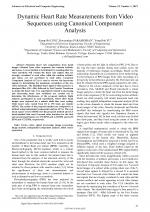| 3/2019 - 5 |
Dynamic Heart Rate Measurements from Video Sequences using Canonical Component AnalysisLING, S.-S. |
| Extra paper information in |
| Click to see author's profile in |
| Download PDF |
Author keywords
video signal processing, image processing, image analysis, independent component analysis, blind source separation
References keywords
rate(7), heart(7), biomedical(7), optics(6), video(5)
Blue keywords are present in both the references section and the paper title.
About this article
Date of Publication: 2019-08-31
Volume 19, Issue 3, Year 2019, On page(s): 41 - 48
ISSN: 1582-7445, e-ISSN: 1844-7600
Digital Object Identifier: 10.4316/AECE.2019.03005
Web of Science Accession Number: 000486574100005
SCOPUS ID: 85072202782
Abstract
Dynamic heart rate computation from facial images obtained from video sequences has random artifacts and noises. A novel method is formulated by assuming that two video durations will contain the heart rate signals that are strongly correlated to each other while the random artifacts and noises are not correlated to each other. Canonical Component Analysis (CCA) is used to recover the heart-rate signals by determining the maximum correlation of the two video durations. The identified heart signal is then passed to a bandpass filter (0.8 - 4Hz) followed by Fast Fourier Transform to obtain the heart rate. Two experiments related to increasing and decreasing heart rate variations are carried out to determine the effectiveness of the proposed method. Eight subjects participated in each experiment, where their facial images were captured for a minute while they were cycling. Their heart rates varied from 83 to 153 beats per minute (BPM). The results of the proposed method are compared to a method using independent component analysis (ICA). The root mean square errors (RMSE) for the proposed method and ICA based-method that used 5-second video duration for the first and second experiments are 3.70 BPM and 2.33 BPM and 14.36 BPM and 9.72 BPM, respectively. |
| References | | | Cited By |
Web of Science® Times Cited: 2 [View]
View record in Web of Science® [View]
View Related Records® [View]
Updated 3 weeks, 6 days ago
SCOPUS® Times Cited: 3
View record in SCOPUS® [Free preview]
View citations in SCOPUS® [Free preview]
[1] The Determination of Absorption and Reduced Scattering Coefficients of Optical Phantoms Using a Frequency-Domain Multi-Distance Method in a Non-contact Manner, BAL, U., UTZINGER, U., BAL, A., MORAL, O. T., Advances in Electrical and Computer Engineering, ISSN 1582-7445, Issue 2, Volume 20, 2020.
Digital Object Identifier: 10.4316/AECE.2020.02001 [CrossRef] [Full text]
[2] Is Continuous Heart Rate Monitoring of Livestock a Dream or Is It Realistic? A Review, Nie, Luwei, Berckmans, Daniel, Wang, Chaoyuan, Li, Baoming, Sensors, ISSN 1424-8220, Issue 8, Volume 20, 2020.
Digital Object Identifier: 10.3390/s20082291 [CrossRef]
[3] Heart rate measurement and blur image quality metric via image processing: An overview, Paramesran, Raveendran, Hassan, Mohd Fikree, FIRST INTERNATIONAL CONFERENCE ON COMPUTATIONAL SCIENCE & DATA ANALYTICS: Incorporating the 1st South-East Asia Workshop on Computational Physics and Data Analytics (CPDAS 2021), ISBN , Issue , 2023.
Digital Object Identifier: 10.1063/5.0140251 [CrossRef]
Disclaimer: All information displayed above was retrieved by using remote connections to respective databases. For the best user experience, we update all data by using background processes, and use caches in order to reduce the load on the servers we retrieve the information from. As we have no control on the availability of the database servers and sometimes the Internet connectivity may be affected, we do not guarantee the information is correct or complete. For the most accurate data, please always consult the database sites directly. Some external links require authentication or an institutional subscription.
Web of Science® is a registered trademark of Clarivate Analytics, Scopus® is a registered trademark of Elsevier B.V., other product names, company names, brand names, trademarks and logos are the property of their respective owners.
Faculty of Electrical Engineering and Computer Science
Stefan cel Mare University of Suceava, Romania
All rights reserved: Advances in Electrical and Computer Engineering is a registered trademark of the Stefan cel Mare University of Suceava. No part of this publication may be reproduced, stored in a retrieval system, photocopied, recorded or archived, without the written permission from the Editor. When authors submit their papers for publication, they agree that the copyright for their article be transferred to the Faculty of Electrical Engineering and Computer Science, Stefan cel Mare University of Suceava, Romania, if and only if the articles are accepted for publication. The copyright covers the exclusive rights to reproduce and distribute the article, including reprints and translations.
Permission for other use: The copyright owner's consent does not extend to copying for general distribution, for promotion, for creating new works, or for resale. Specific written permission must be obtained from the Editor for such copying. Direct linking to files hosted on this website is strictly prohibited.
Disclaimer: Whilst every effort is made by the publishers and editorial board to see that no inaccurate or misleading data, opinions or statements appear in this journal, they wish to make it clear that all information and opinions formulated in the articles, as well as linguistic accuracy, are the sole responsibility of the author.



